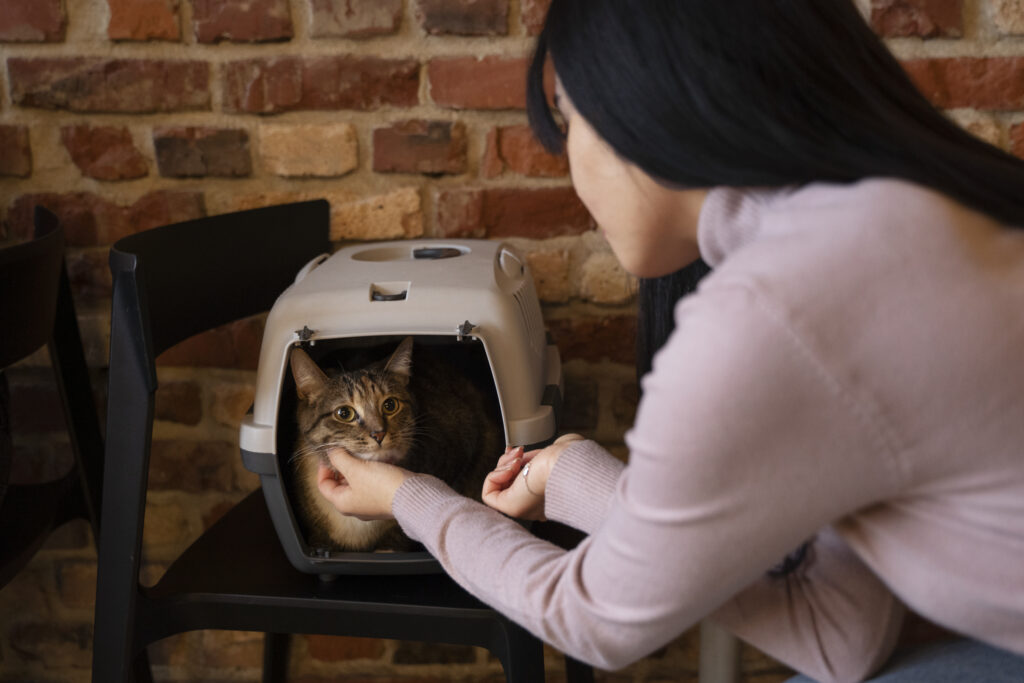
Introduction
Introducing a new carrier to your cat can be a daunting task. Cats are naturally cautious creatures, and many dislike confined spaces, especially if they associate them with stressful events such as trips to the vet. The challenge of introducing your cat to a carrier stems from this innate tendency to avoid small, enclosed areas, which can make the process difficult. However, with patience, consistency, and the right approach, you can help your cat become more comfortable with their carrier, making future travels and vet visits much less stressful for both you and your feline companion.
Start Slowly and Early
The key to getting your cat used to their new carrier is to start the process well in advance of any planned trips. Cats need time to explore and get comfortable with new objects, and introducing the carrier early allows them to do this on their own terms. Start by placing the carrier in a familiar room where your cat spends a lot of time. Leave the door open so your cat can investigate the inside at their own pace without feeling trapped or forced.
Make the Carrier Inviting
A carrier that smells and feels familiar will be much more inviting to your cat. To make the carrier more comfortable, place one of your cat’s favorite blankets or toys inside. The familiar scent of these items can help reduce anxiety and make the carrier feel like a safe space. You can also use treats or a sprinkle of catnip to encourage your cat to enter the carrier voluntarily. The goal is to create a positive association with the carrier, so your cat views it as a place of comfort rather than fear.
Gradual Exposure
Once your cat is comfortable going in and out of the carrier on their own, start closing the door for short periods while they’re inside. Initially, leave the door closed for just a few seconds, then gradually increase the duration. If your cat shows signs of distress, such as meowing or scratching, open the door and allow them to exit. Patience is key—forcing your cat to stay inside for too long can create a negative association with the carrier.
Create Positive Associations
Each time your cat enters the carrier voluntarily, reward them with praise, petting, or a treat. Positive reinforcement is a powerful tool in building a strong, positive connection between your cat and the carrier. Over time, your cat will learn that the carrier is not something to be feared but rather a place where good things happen. You can even try feeding your cat in or near the carrier to further strengthen this positive association. The more frequently your cat associates the carrier with rewards, the more willing they will be to enter it without hesitation.
Practice Short Trips
Once your cat is comfortable staying inside the carrier with the door closed, it’s time to practice short trips. Start by carrying your cat around the house in the carrier for just a few minutes. This helps your cat get used to the sensation of being carried without the added stress of being in a moving car. Gradually increase the length of these practice sessions and, when your cat seems calm, take them on a short car ride around the block. The goal is to help your cat associate the carrier with positive experiences, so be sure to reward them with treats and affection after each practice session.
It’s crucial to keep these initial trips short and stress-free. Avoid loud music, sudden movements, or bumpy rides, as these can heighten your cat’s anxiety. With each successful outing, your cat will begin to feel more comfortable with the experience of being in the carrier and car.
Minimize Stress During Travel
When it’s time for a real trip, take steps to minimize your cat’s stress. Ensure that the carrier is secure in the car to prevent it from moving or tipping over during travel. You can place a towel or blanket over the carrier to reduce visual stimuli and create a more calming, enclosed environment. Cats often feel safer in a darker, quieter space.
If your cat is particularly anxious about travel, consider using a pheromone spray inside the carrier. These sprays mimic the calming pheromones that cats produce naturally and can help reduce anxiety during trips. Another tip is to place the carrier on the back seat or floor of the car to minimize movement during the drive.
Frequent Use of the Carrier
One of the best ways to ensure your cat remains comfortable with their carrier is to use it regularly, not just for trips to the vet. Take your cat on short trips around the neighbourhood, or simply allow them to spend time in the carrier at home. Frequent exposure to the carrier in non-stressful situations helps prevent your cat from associating the carrier exclusively with negative experiences.
Choosing the Right Carrier
The type of carrier you choose can also play a role in how easily your cat adapts to it. Some cats prefer hard-sided carriers with plenty of ventilation, while others feel more secure in soft-sided carriers. Look for a carrier with multiple openings to make it easier to coax your cat inside. Additionally, ensure that the carrier is the appropriate size for your cat—there should be enough room for them to stand up, turn around, and lie down comfortably.
Conclusion: A Calm and Comfortable Journey
Getting your cat used to their new carrier takes time and patience, but with the right approach, you can make the process much smoother. By creating positive associations with the carrier, providing gradual exposure, and practising short trips, you’ll help your cat feel more at ease. Remember, a comfortable and stress-free cat is key to ensuring that future travels, whether to the vet or on a family vacation, go smoothly. With some patience and understanding, your cat will soon view their carrier as a cozy, safe place rather than a source of anxiety.
